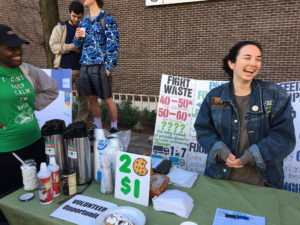

Sustainability is a topic that has increasingly garnered attention, and the amount of advocates have grown tremendously in recent years.
Here at Georgia State, implementing practices like switching over to a tobacco-free campus in 2014, aids in reducing harmful effects on the environment. The university’s involvement with environmental protection is a part of a larger trend, as the entire nation has shown interest in doing their part to propel this cause.
In a 2010 Huffington Post article, writer Stephen Cohen stated that a 2009 report from polling agency Harris Poll, alluded that most Americans claim they had been active in reducing their ecological footprints. Such practices included recycling electronics, monitoring electricity use and drinking tap water over bottled.
One student organization is wielding a different method, though with a similar goal.
With its focus on hunger and food waste, the Panther Food Recovery Network (PFRN) is out to leave a constructive imprint for sustainability.
A Worthy Introduction
PFRN is the Georgia State spinoff of the Food Recovery Network, a nationwide organization that developed its charge six years ago.
“The Food Recovery Network was founded by Ben Simon in 2011 at University of Maryland and since then, we have grown to 198 chapters,” Chapter President Rajah Steede said.
Hosting events frequently around campus has allotted the novel foundation an executive team, volunteers and some acknowledgement. However, its good deeds – guided by a set of core goals – is what truly gravitates people to the group.
“PFRN is an organization that focuses on sustainability and we are proud to be a part of the largest student movement against food waste and hunger in the United States. Our mission is ‘Fighting Waste. Feeding People’,” Steede said.
This angle of targeting hunger through recycling efforts make the recuperation team the only student-led organization at Georgia State in their realm. Furthermore, the group goes beyond merely handing out food to those in need by extending their work to informing the public on its costly consumption habits.
“I would like for the GSU community, staff and students, to know that 40 percent of food is thrown out within the U.S. every year [and] this could feed 25 million Americans,” Steede said. “The homeless population is about 3.5 million, which is equal to 14 percent of the 25 million Americans that the food waste could account for.”
Doing Necessary Work
The Atlanta campus is directly situated amongst an established homeless population, giving the members ample opportunity to do their necessary work. A walk to Aderhold Learning Center shows that extra assistance is needed within the community. The network appears to have recognized this, as it has already taken on the job and partners with another nonprofit to do so.
“Safe House is a community outreach organization that is geared to help transition people experiencing homelessness from the streets of Atlanta to self-sufficiency. SafeHouse is the community outreach where PFRN donates the perishable food,” Steede said.
With the passion and tenacity to properly serve, PFRN makes doing good seem effortless. At their “Socks for Cocoa” event on Jan. 24, members like Destiny Elliott, the communications coordinator, greeted students with enthusiasm, while encouraging them to donate socks or $1. The trade off was a cup of hot chocolate on a day with strong winds and chill. Their approach is paying off.
“Since the establishment of the PFRN in April 2016, we have recovered 8,167 pounds of food that equates to 6,282 meals,” Steede said. “So on Tuesdays and Thursdays from 8 a.m. to 9 a.m., we unite students on campus to fight food waste and hunger by recovering perishable food that would otherwise go to waste from Piedmont North and Patton dining halls and donate it to a community outreach that [assists] people in need.”
In addition to connecting with students, the recovery network is building a rewarding relationship with Safe House and the City of Atlanta.
“PFRN has had a major impact on the surrounding community. For instance, when we provide Safe House with food, the money that they previously allocated for purchasing these items can now be used in assisting their customers during their transitional stage whether it be providing clothes, shoes, tools etc,” Steede said.
Leadership and Getting Involved
Even though their presence on campus is less than a year old, PFRN has managed to accomplish remarkable things. The team is still small, but their leadership is impressive. Steede, who was only recently appointed as president, has been involved since August 2016. She manages authentically by conserving the group’s original commitments and strategizing how to spread the word.
“We are trying to reach out to students, as we are on the brink of searching for more volunteers. Yes, we are heard of but not known well enough [throughout] the student body,” Steede said. “In the past, PFRN had numerous bake sales and promotional events which [proved] to be beneficial. At this moment, we have not had [many] events as the semester just started but stay tuned because we have a few in store for the GSU community.”
Elliott’s public relations chops help bring people in. It works because there is genuine respect for the organization’s aims.
“I did not understand that leftover chicken on my plate will potentially save community shelters more expenses than I could imagine,” Elliott said. Now, fighting food waste and feeding people is a slogan that repeats in my head as I walk through the dining hall, watching residents unintentionally dispose valuable resources. Panther Food Recovery Network has become a lifestyle.”
If anyone is interested in getting involved with Panther Food Recovery Network, send an email to pantherfrngsu@gmail.com. Find them on Instagram @pantherfrngsu, and Facebook.com/pantherfoodrecoverynetwork1.
